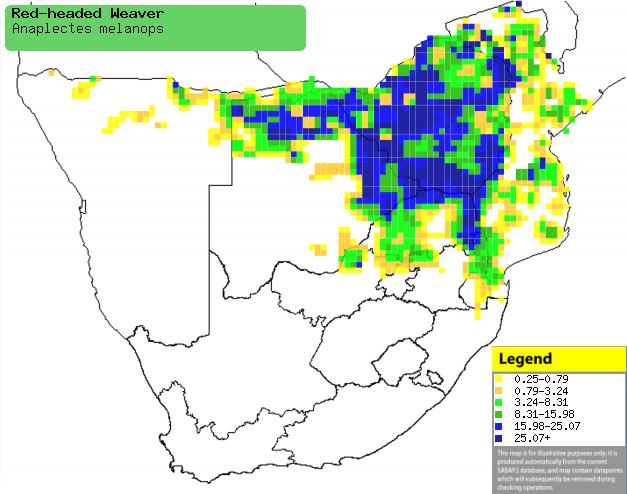|
Anaplectes melanotis
(Red-headed weaver)
[= Anaplectes rubriceps]
Rooikopwewer
[Afrikaans]; Ndzheyana ya nhloko ya ka phsuku [Tsonga]; Scharlaken wever
[Dutch]; Tisserin écarlate [French]; Scharlachweber [German];
Tecelão-de-cabeça-vermelha [Portuguese]
Life
> Eukaryotes >
Opisthokonta
> Metazoa (animals) >
Bilateria >
Deuterostomia > Chordata >
Craniata > Vertebrata (vertebrates) > Gnathostomata (jawed
vertebrates) > Teleostomi (teleost fish) > Osteichthyes (bony fish) > Class:
Sarcopterygii (lobe-finned
fish) > Stegocephalia (terrestrial
vertebrates) > Tetrapoda
(four-legged vertebrates) > Reptiliomorpha > Amniota >
Reptilia (reptiles) >
Romeriida > Diapsida > Archosauromorpha > Archosauria >
Dinosauria
(dinosaurs) > Saurischia > Theropoda (bipedal predatory dinosaurs) >
Coelurosauria > Maniraptora > Aves
(birds) > Order: Passeriformes
> Family: Ploceidae
Distribution and habitat
Occurs across much of sub-Saharan Africa, excluding the
lowland forests of West Africa and central DRC, from Senegal to Somalia south to
southern Africa. Here it is uncommon to fairly common from north-eastern Namibia
through northern and eastern Botswana to Zimbabwe, Mozambique and north-eastern
South Africa. It generally prefers broad-leaved (especially miombo (Brachystegia)
woodland, Acacia savanna, bushveld and gardens, usually of farms.
|
 |
|
Distribution of Red-headed weaver in southern Africa,
based on statistical smoothing of the records from first SA Bird Atlas
Project (©
Animal Demography unit, University of
Cape Town; smoothing by Birgit Erni and Francesca Little). Colours range
from dark blue (most common) through to yellow (least common).
See here for the latest distribution
from the SABAP2. |
Predators and parasites
It has been recorded as prey of the following animals:
Brood parasites
It has been recorded as host of the
Diderick
cuckoo.
Food
It mainly eats arthropods, supplemented with seeds and
fruit, gleaning food from the foliage of trees, bushes and creepers. It also
hawks insects aerially and plucks spiders from their webs, often joining mixed
species foraging flocks. The following food items have been recorded
in its diet:
- Arthropods
- insects
-
spiders
- Stegodyphus (social spiders)
- Plants
- seeds
- fruit
- Tapinanthus leendertziae (mistletoe)
Breeding
- Monogamous but sometimes polygynous, as one male may mate with multiple
females within a colony.
- The nest is built solely by the male, consisting of an upside-down
bottle-shaped structure (i.e. an rough oval with a vertical entrance hole at
the base) made of leaf midribs, twigs, grass stems, broad leaves and
tendrils. Once it is approved by the female she lines the interior with bark
fibres, feathers, dry grass or leaves. It is typically strung from a few
twigs beneath the canopy of a tree, such as the Baobab (Adansonia
digitata), but it also regularly uses man-made objects such as windmill
vanes, telephone wires and edge of thatched roofs. It often nests in the
vicinity of other weaver species or even raptors such the African hawk-eagle
(Aquila spilogaster).
- Egg-laying season is from July-February, peaking from
September-November.
- It lays 1-4 eggs, usually 2-3 eggs, which are incubated mainly by the
female for about 12-13 days.
- The chicks are fed by both sexes but mostly the female, leaving the nest
after roughly 17 days.
Threats
Not threatened.
References
-
Hockey PAR, Dean WRJ and Ryan PG 2005. Roberts
- Birds of southern Africa, VIIth ed. The Trustees of the John Voelcker
Bird Book Fund, Cape Town.
|
